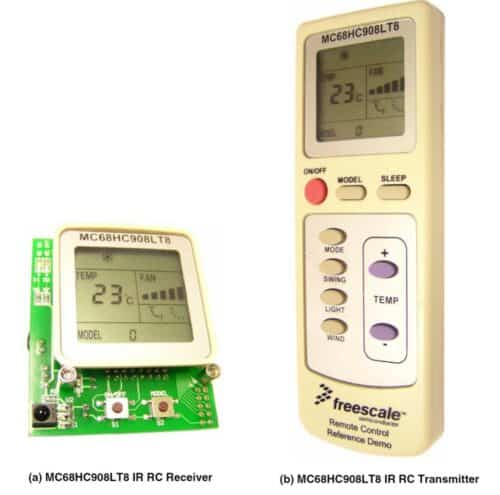A wireless infrared remote control reference design for air conditioners and small home appliances, ensuring low power consumption and optimized performance.

In air conditioners and small home appliance applications, the demand for a wireless user interface, such as an infrared (IR) remote control unit, is essential. This unit facilitates data transmission from a transmitter to a receiver through infrared communication. NXP Semiconductors have launched the reference design for multi-button IR remote control to simplify the design process. The reference design comprises both the transmitter and receiver units. One notable feature of this design is the presence of a 16-pin MON08 programming interface header. This interface facilitates in-circuit Flash programming and debugging capabilities for seamless integration within the remote control transmitter and receiver units.
The design is based on the MC68HC08LT8 low-cost microcontroller unit (MCU), which belongs to the family of 8-bit MCUs. The design adheres to specific performance specifications, including low power consumption in standby mode for the transmitter unit and a low operating voltage requirement. The device’s maximum internal bus frequency varies depending on the operating voltage. At a 5-V operating voltage, the maximum frequency is 4 MHz, while at a 3-V operating voltage, it is 2 MHz. The device features a dual oscillator module, including a 32.768 kHz crystal oscillator and a 1 to 16 MHz crystal oscillator. It has 8,192 bytes of user Flash memory and 128 bytes of on-chip random-access memory (RAM). It is essential to incorporate certain fundamental control parameters to cater to the specific application of an air conditioner remote controller. These parameters include the ability to control power ON/OFF functionality, transmit temperature data, and provide options for mode selection.
The IR remote control transmitter unit is seamlessly integrated into an optimized Printed Circuit Board (PCB) layout to provide a practical and user-friendly solution. This compact design is tailored to fit within a standard remote controller casing, with essential components such as a keypad, Liquid Crystal Display (LCD) display, and battery holder. The MCU, specifically designed for remote control applications, incorporates two independent clock drives. This design choice is driven by the need to meet the low power requirements during standby mode, which is a crucial aspect of remote control applications. The MCU can optimize power consumption by incorporating two clock sources while maintaining reliable functionality, ensuring efficient operation in remote control scenarios. The transmitter unit features a keypad with nine buttons, whereas the receiver unit has only two buttons. Since the power for the receiver is derived directly from the AC main in the air conditioner, power-saving measures are unnecessary. Consequently, there is no need to compel the receiver system into standby mode.
NXP Semiconductors has tested this reference design. It comes with a Bill of Material (BOM), schematics, etc. You can find additional data about the reference design on the company’s website. To read more about this reference design, click here.








